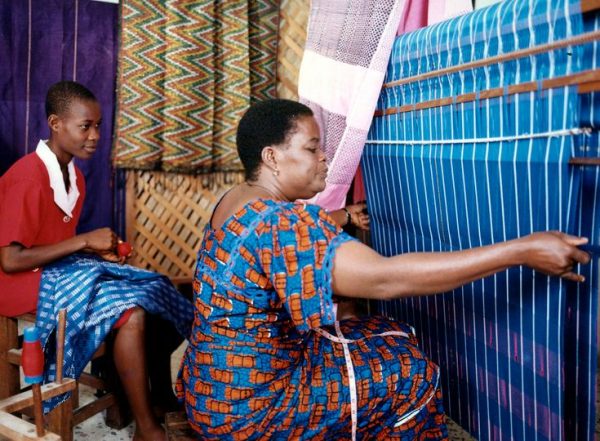Nigeria’s traditional fabrics have been in existence as far back as the 13th and 14th centuries. Different regions and ethnic groups in Nigeria have their distinct local fabrics. The Igbos have Akwete, the Hausas, Kura cloth, and the Yorubas, Aso-Oke. Though these fabrics are made in different regions and are commonly worn by people in the region, they are still worn by people in other regions too.
Read more about Fashion
Meaning of Akwete
Akwete was named after the village where the art started, the Akwete community in Abia state. The fabric is known as “Mkpuru Akwete” which directly translates as “Akwete fabric”.
Akwete is a decorative cloth with complex weave designs, creating intricate geometric patterns, made with many vibrant colors. It is usually made into wrappers for women to wear, and it is made by the Igbo women of Nigeria.
Origin of Akwete
The origin of Akwete can be traced to a woman known as Dada Nawkwata. She is generally believed to be the originator of Akwete as the story have been passed through oral tradition. According to history, she learnt the trade herself by studying and unravelling threads from Acham, an open woven cotton cloth brought to the village through trade with the Portuguese around the 14th and 16th centuries.
When she learnt the art, she began to try different designs, until she achieved what is known today as Akwete. During her time, women were involved in more economic activities as weaving was a new venture and not very lucrative. Weaving Akwete became more prominent after she died. Weavers learnt the trade through Dada‘s friend, a deaf and dumb woman who was always by her side when she weaved.
Location of the weavers
It is no news that Akwete is from the Igbos, the Easterners in Nigeria. However, the Eastern part of Nigeria is not a small piece of land but a large landscape divided into sections. Weavers of Akwete cloth can be found in the Ndoki town of Akwete in Ukwa East local Government Area of Abia State.
Patterns of Akwete
Weavers of Akwete claim that they have different patterns and designs which are over a hundred. They attribute their creativity to the gods. Therefore, every weaver has their unique design. No weaver is expected to copy another weaver, and to check this, they have a weaver association.
Sign up to the Connect Nigeria daily Newsletter
Different motifs or patterns have their different uses. There is the ‘Ilaki’ which is reserved for royalty, because the fabric is said to have king-like qualities. In the olden days, if someone that is not royalty wears the fabric, they will be punished or sold into slavery. There is also the ‘Ebe‘ design worn by pregnant women and warriors.
There are four main patterns of Akwete fabric: ‘Etirieti‘, the plain pattern made up of stripes and squares, ‘Akpukpa’, the vibrant and colourful design, ‘Ahia’, the complex design and ‘Ogbanaonweya’, the intricate design.
Wowen and Akwete
Only women are allowed to weave Akwete. Men are forbidden to do so. Any man that tries it will be punished and cursed. Weaving of Akwete is a type of women empowerment. It is seen as a livelihood for women. Men are allowed to sell and build the materials needed for weaving but are not allowed to weave.
Modernization of Akwete
In recent times, Akwete has been incorporated into contemporary fashion through talented and creative fashion designers like Kenneth Ize and Chinasa Chukwu. Emmanuel Okoro, the owner of Emmy Kasbit, is the most popular designer that uses Akwete fabric. His designs have international reputation and exposure.
It is beautiful to see that Akwete has not lost its originality, and the people of Akwete are still in sole control of their fabric. Akwete is a must-have for everyone.
References
Fibre2Fashion.com
Vanguard
Featured image source: The Guardian Nigeria
Did you find this article useful? Contact us: [email protected]


